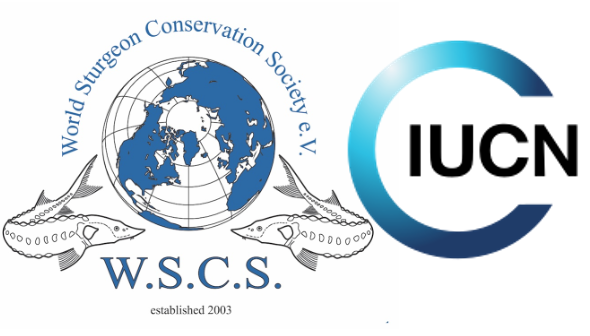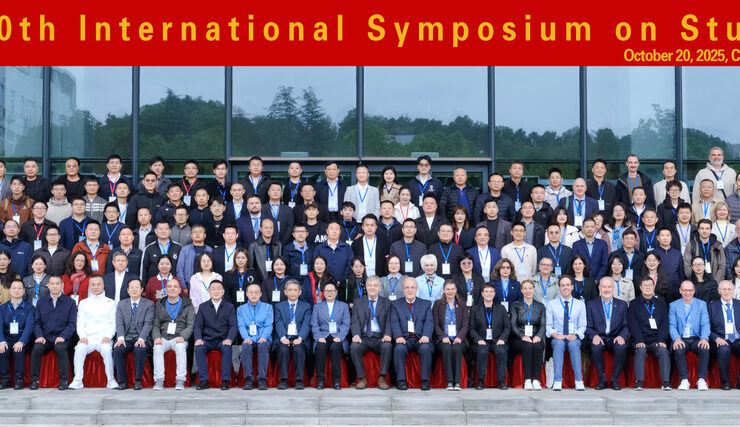IUCN Sturgeon Specialist Group
Outcome of the Workshop held during the 10th International Symposium on Sturgeon, Yichang China, October 2025.
During the IUCN workshop held on October 22nd with members of the SSG and interested parties one Agenda item was the presentation of the suggested revision of the taxonomy of sturgeons by Brownstein and Near (2025). The paper presents a significant update to the phylogeny of sturgeon (Acipenseridae), proposing a new generic taxonomy that reclassifies the traditional genera Acipenser and Huso. This revised taxonomy resurrects the genus Sinosturio and moves sixteen species from Acipenser into Huso and Sinosturio. It also confines Acipenser to only three species. Specifically, Brownstein and Near’s study identifies five monophyletic genera: Acipenser, Scaphirhynchus, Pseudoscaphirhynchus, Huso, and the resurrected genus Sinosturio. Acipenser is now defined as containing only three species, while sixteen species were moved from Acipenser to Huso. The resurrected genus Sinosturio includes species such as S. dauricus (previously classified as Huso dauricus). The new taxonomy is based on a combination of mitochondrial and nuclear DNA data and morphological data. In response, Kottelat and Freyhof (2025) noted several nomenclatural errors.
Four extant genera are commonly recognized within the family: Acipenser; Huso; Scaphirhynchus; and Pseudoscaphirhynchus. The most species-rich genus, Acipenser, is widely considered to be paraphyletic, though the monophyly of all genera except Scaphirhynchus has been questioned in recent years. Multiple phylogenetic hypotheses have been proposed using mitochondrial and nuclear markers, karyotype structures and ploidy levels, and morphological data, resulting in a proliferation of competing phylogenetic topologies and minor taxonomic revisions. A recent molecular phylogenetic analysis based on previously generated, publicly available sequence data was used as the basis for broad-scale, genus level taxonomic changes.
Considering the importance of a reliable classification for species threatened with extinction, which are listed in numerous action plans, as well as regional (e.g., HELCOM and the Bern Convention) and international legal contracts (e.g., CITES and CMS), the IUCN SSC Sturgeon Specialist Group (SSG) and the World Sturgeon Conservation Society (WSCS) discussed the proposed changes at a joint meeting during the 10th International Sturgeon Symposium (ISS 10) in Yichang, China, on October 22, 2025.
The participants of this meeting agreed not to support the proposed revision. Since such dramatic changes require a reliable foundation, which neither Bronstein & Near (2025) nor Kottelat & Freyhof (2025) presented.
It was unanimously agreed during the meeting that the suggested revision is not robustly supported.
For example, the taxonomy is not supported by synapomorphies in morphological characters, those morphological features named are not defined and therefore not readily applicable, furthermore, there is weak statistical support for many of the clades presented. In addition, the entire systematic is based upon a data set that contains substantial missing data. This revision does not align with the phylogeny, especially the polyploidy events in the family. Furthermore, it does not consider the evidence for introgression of mitochondrial and nuclear loci among species. This introgression can confound molecular phylogenetic results. Furthermore, the drastic alteration to the classification could negatively impact the protection of these fish. To address the tension between phylogenetic resolution and practical utility, the participants of the meeting proposed a conservative classification for Acipenseridae that recognizes three extant genera and five exclusively fossil species. The proposed recognition of A. colchicus (Marty, 1940) by Kottelat and Freyhof (2007) has been rejected as premature (Vasil’eva and Vasil’ev, 2021). They described it as a distinct species, separate from A. persicus, but provided little evidence beyond their identification key.
In conclusion, future taxonomic modifications must be made cautiously and based on a comprehensive analysis of all taxa within the family. This analysis should include sound morphological, mitochondrial, and nuclear data in order to better assess the peculiarities and challenges presented by sturgeons for each of these data sources. Whole genome sequencing for multiple species was presented at ISS 10, which provides higher taxonomic resolution. These data must be considered. As Dillman et al. (2007:295) stated, “the taxonomy of sturgeon species should not be altered on the basis of any single data set…[and] we do not feel that the data sets assembled to date provide sufficient resolving power to alter any currently recognized genera.” Although this was written in 2007, we, as researchers with considerable direct experience working collaboratively on the biology of sturgeons (including genetics, morphology, ecology, evolution, and conservation biology), collectively agree that it remains true today. Until then, changes in classification for the family will result in undue and perhaps unforeseen issues.
Therefore, we suggested to maintain the existing phylogeny and only make the following changes: the dissolution of Huso, as proposed by Vasil’eva et al. (2009), as well as the recognition of A. oxyrinchus and A. desotoi as distinct taxa, as proposed by Robins et al. (2018).
Yichang, October 22nd 2025
References
Brownstein, C.D. & Near, T.J. (2025) Toward a phylogenetic taxonomy of sturgeons (Acipenseriformes: Acipenseridae). Bulletin of the Peabody Museum of Natural History, 66, 3–24.
Dillman, C.B., Wood, R.M., Kuhajda, B.R., Ray, J.M. Salnikov, V.B. & Mayden, R.L. (2007) Molecular Systematics of the Shovelnose Sturgeons (Scaphirhynchinae) of North America and Central Asia. Journal of Applied Ichthyology, 23, 290-296.
Kottelat, M. & Freyhof, J. (2025) Huso Lovetzky, 1834, a junior synonym of Sterletus Rafinesque, 1820, and comments on some other generic names for sturgeons (Chondrostei: Acipenseridae). Zootaxa, 9, 538–548.
Marty, V.J. (1940) Systematics and biology of the Russian sturgeon of the Caucasian coast of the Black Sea. Zoologichesky Zhurnal, 19, 865-872.
Robins, R.H., Page, L.M., Williams, J.D., Randall, Z.S. & Sheehy, G.E. (2018) Fishes in the Fresh Waters of Florida: An Identification Guide and Atlas. University of Florida Press, Gainesville, USA
Vasil’eva, E. D., Vasil’ev V. P., Shedko, S.V., & Novomodny, G.V. (2009) The revision of the validity of genus Huso (Acipenseridae) based on recent morphological and genetic data with particular reference to the Kaluga. Journal of Ichthyology, 49, 861–867.
Vasil’eva, E.D. & Vasil’ev, V.P. (2021) Taxonomic relations of Russian and Persian sturgeons (genus Acipenser, Acipenseridae): an updated synthesis. Journal of Ichthyology, 61, 17- 32.





